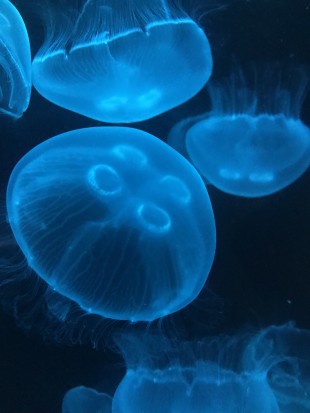
Moon Jellyfish
Jellyfish are invertebrates that use a form of jet propulsion to move through the water. They are famous – and feared -- for their stinging cells, which they use to stun prey. However, moon jellies are the least dangerous jellyfish to humans.
Range & Habitat
Moon jellyfish are found in oceans around the world. They prefer a warm environment and often live near coastlines in the Atlantic, Pacific, and Indian oceans.These organisms can live in saltwater or brackish (mixed salt- and freshwater) environments, and waters between 45- and 70-degrees Fahrenheit offer them the best chance of survival.
Conservation Status: Least Concern
This species is not threatened,but can serve as an indicator that marine ecosystems are out of balance. Unlike other larger species, they can thrive in otherwise uninhabitable waters. This means that as ocean health declines, moon jelly populations can actually increase! This is true in environments that experience human-induced phenomenon like overfishing, ocean warming, ocean acidification and pollution.
Diet
In the Wild: Zooplankton that sticks to their short tentacles as they move through ocean environments.
At the Zoo: Brine shrimp
Life Span
Fun Facts about the Moon Jellyfish
- Jellyfish are the oldest multi-organ animal, with fossil evidence indicating they existed over 500 million years ago, predating dinosaurs.
- Jellyfish have been studied widely by scientists, and moon jellies even went into space as an experiment aboard the Space Shuttle Columbia in 1991.
- Jellyfish have no brain, heart or blood – but they do have a sort of nervous system or “nerve net” that allows them to sense light, balance, chemical changes and touch.
Sources
Monterey Bay Aquarium: https://www.montereybayaquarium.org/animals/animals-a-to-z/moon-jelly
National Marine Sanctuary Foundation: https://marinesanctuary.org/blog/sea-wonder-moon-jelly
Virginia Institute of Marine Science: https://www.vims.edu/bayinfo/jellyfish/lifecycle/


